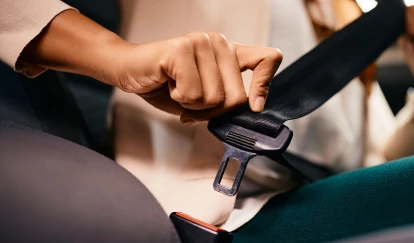
Share This Article
Do you know the leading cause of death for Americans from birth to age 30? It's motor vehicle accidents. That's an alarming fact, but there's something you can do to protect yourself every time you get into a car or truck: wear your seatbelt. Seatbelts are proven to dramatically reduce serious injuries and the risk of death during motor vehicle accidents. Unfortunately, of more than 33,000 people killed in car and truck accidents each year, over 50% weren't wearing their seatbelts!
If you're the driver or a front-seat passenger, buckling up reduces your chance of being killed in an automobile accident by 45% and reduces serious injuries by 50%, according to the National Highway Traffic Safety Administration. So why doesn't everyone buckle themselves and their loved ones properly each time they get into their car or truck? It's a mystery.
As Richmond auto accident attorneys and tractor trailer accident lawyers, we're putting the word out: wearing a seatbelt is crucial to preventing death and serious injuries in a car or truck accident. Happily, seatbelt use is increasing, but more than 1 in 7 people still don't use them regularly. Following are some commonly asked questions about seatbelts:
- If I'm riding in the back seat without my seatbelt, aren't I safe from injury in a car crash? And worse: you're more than twice as likely to kill the person who's driving, according to a study by the Centers for Disease Control. Multiple studies show a higher risk of death for others in the car or truck when rear-seat passengers aren't properly restrained. Backseat riders who wear their safety belts reduce their risk of death in an accident by 60%.
- If I'm only driving a mile or two in my pick-up truck and everyone won't fit in the cab, can't a few people just ride in the bed of the truck? A truck's bed is designed to transport cargo, not people. That's why there aren't seatbelts in the bed of your truck. If you are ejected from a vehicle during a crash, death is almost always certain. To keep yourself safely inside your vehicle during an accident, you have to wear a seatbelt. And further, just because you're not going far is no excuse to ignore wearing a seatbelt. Most deadly crashes occur within 25 miles of home and at under 40 mph.
- If I get into a crash with another car, won't my large truck or SUV protect me? Pick-up trucks are even more dangerous than cars for victims of crashes who aren't wearing seatbelts. Research indicates you're more likely to be killed during an unrestrained crash in a pick-up truck as opposed to a similar unrestrained crash in a car.
- If I am traveling at slow speeds, can't I just brace myself against the dashboard or steering wheel?During an accident, the impact forces acting on your body makes it feel like thousands of pounds of energy in motion. It's such a strong force that no human has the strength to brace against it. Also, accidents happen suddenly, without enough time to prepare and brace yourself accordingly, even if you could withstand the force.
- What if I'm pregnant? When you're pregnant, you have two lives to protect, and you should definitely wear your seatbelt. Be sure to position the seatbelt correctly: a pregnant woman should secure the lap belt portion of the seatbelt low, beneath the abdomen ‒ flat on the tops of her thighs. The shoulder restraint should be positioned in the center of the chest and off to the side of her belly.
If you have been injured at work or through the negligence of another individual or entity, contact us at (804) 999-9999 or or use the form below to connect with our legal team. We will fight to get you the justice you deserve.
